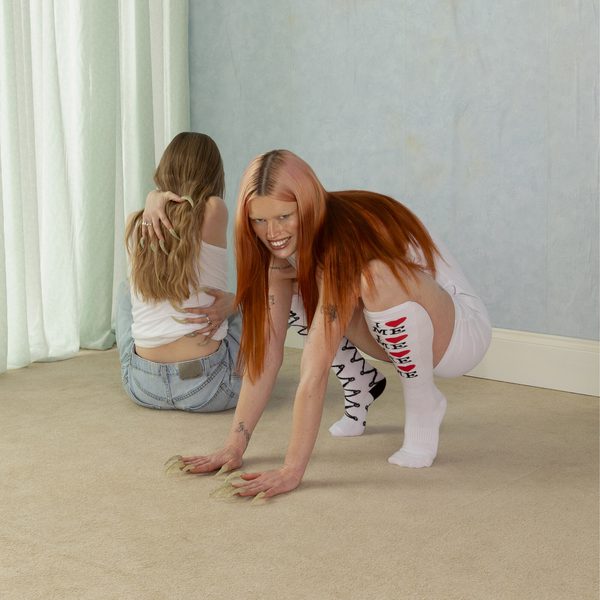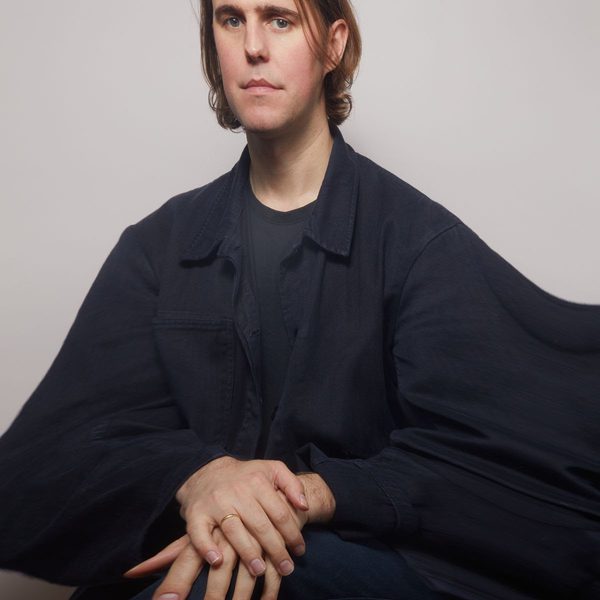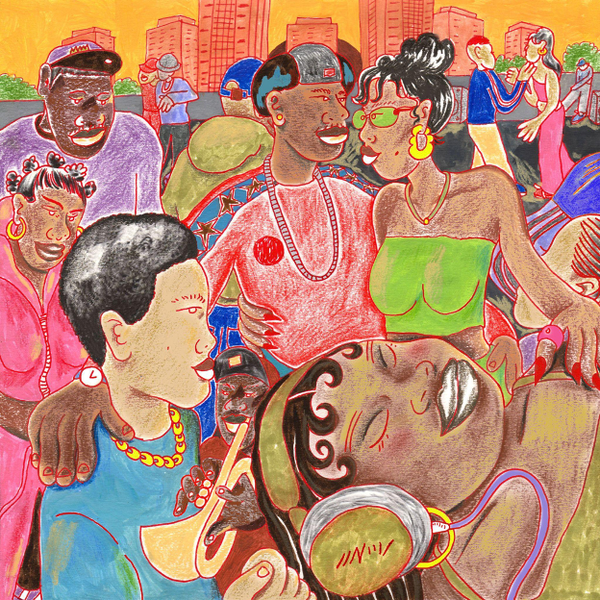
Gira The Seer : Best Fit meets Swans
I meet Swans “band leader” (his term) Michael Gira outside on the balcony of London’s Koko, an hour or so before he’s due to ascent its stage. The last time he and I were in the same room, he wasn’t aware of my presence, but I was very aware of his – he was alone, hypnotically strumming an acoustic guitar at this year’s Primavera Sound festival in Barcelona, spitting into the air and slapping himself around the face, screaming.
Live shows, whether they be solo and quiet or full band and cacophonous, obviously take a lot out of him. And here I am, conducting his third interview of the evening, something which – knowing what he’s about to put himself through – surely can’t be what he wants to be doing right now. Even though my perception of Gira as a self-flagellating, spittle-covered noise terrorist is challenged within seconds of meeting him (truly, the guy is lovely), I still wonder whether there are days where he arrives at a venue and just doesn’t feel like he can put himself through another night of this again. Does it ever reach that stage?
“All the time. I hate talking about myself to begin with, but the music matters, so… you just do it. I recall on the last tour we’d do ten hour drives before a show, do the show, unload the gear after, drive another three hours, sleep for six hours… and I’m not young! You just feel, ‘oh my god – what am I doing?’ But then you get on stage, and somehow I’m vilified. You just have to do it. That’s what I was made to do, to perform.”
A subsequent glance around the Internet shows it to be full of people calling tonight’s Swans show perhaps the greatest they’ve ever seen – not just by Swans, but by any band. Its nigh-on three hours are the most relentless, repetitive, inventive and confrontational I’ve ever spent in the company of a single band. But the aforementioned solo acoustic show in the beautiful Auditori in Barcelona was equally as intense, albeit for different reasons. He used the gig to introduce some songs from what would become this year’s truly excellent LP The Seer, though neither he nor I can accurately remember which ones. But needless to say, they were drastically different to how they ended up being recorded, in versions which are themselves by no means the same ones we’re treated to tonight. Did many of The Seer’s songs start out in such a fashion?
“Acoustic? Yeah, sure. Many? Well, most I suppose. Even the long ones, like ‘The Seer’ itself, which is 37 minutes on record, that was just an acoustic guitar and voice. Then we started developing it and it became a band song. Not just a guitar song with orchestration, but really a band song. Most of the songs start out with a groove or something on acoustic guitar. Some of them are finished in that I have a full lyric, verses, choruses. Other times I just have a groove, a basic idea that I take to the band, and we start going back and forth. As it happens, we work them out in front of an audience often now. We have the basic structure of course; we’re not masturbating on stage. Those kind of songs develop as a band, the others I record with an acoustic guitar and a drum and then we just go about orchestration. Other ones are about us interacting, how we push and pull and build things sonically.”
I look back at Koko, and ponder the last gig I saw here – Spector, at the Camden Crawl. It wasn’t them I had in mind when I was thinking of the kinds of gigs that are a regular fixture here, but more something their ever quotable front man Fred Macpherson said at the gig; “I’ve seen all of indie’s greats here. I’m talking Do Me Bad Things. Dogs Die In Hot Cars. Dustin’s Bar Mitzvah.” I don’t reel off the same list, but I tell Michael that in years of coming here, I’ve certainly never seen a 37 minute long song.
“In one set during the last tour, ’The Seer’ was 47 minutes long. Haha!”
A slight aside here – when you’re questioning or listening to replies from Michael Gira, he maintains a friendly, involved eye contact throughout. When he laughs, his eyes widen, gazing off in to the distance as if mocking something terrible he’s just remembered. It’s frightening.
“We had to cut some songs from the set because it was supposed to be shorter, but we just ended up making that song longer. It’s not that we’re doing the same thing every time, we’re finding new ways to invigorate it, new ways to find nuance within it when we play.”
Though he’s clearly wholly involved in the moment throughout a Swans show, the band would be lost without his on stage leadership – he conducts them with thrusts of his shoulders and leaps to the heavens in the same way that James Brown used his groin to lead a brass section. But how does he maintain a balance between being personally involved in the music, and keeping everything moving in the right direction?
“Well, I’m the band leader. It’s not an egotistical thing – you need a leader. James Brown, Nina Simone… they’re great band leaders. Howlin’ Wolf was a great band leader. But it’s inherent in me after so many years; I can be playing and counting heads in the audience at the same time. Haha! I’m truly involved in it, but I’m also performing, I’m being an entertainer. It’s a strange dichotomy I suppose. I’m fully in to it, but there’s also a part of me on the outside looking in.”
Those “so many years” he mentions stretch back to the formation of the band in 1982, during which time Swans’ capacity for volume fed legends of audiences defecating or vomiting in terror, fleeing for the exits only to find the doors were locked at the band’s request. It was reportedly in part down to the spread of such half-truths that Gira drew a line under the band in 1997, choosing to focus on his solo work under the name Angels of Light, and running Young God records (responsible for discovering the likes of Devendra Banhart and Akron/Family). In 2010 however, the band returned, with a new line up, and a stack of new songs. What is it, I wonder, about Swans today then that makes it still Swans, still worthy of the name that accompanied them into the limelight in the early Eighties?
“We use a lot of the methods, or tropes you could even say, from the past; the heavy down beat, the swells of sound. But it’s expanded beyond that now. When we first reinvigorated or restated Swans, I just chose some methods that we were using towards the end, from Soundtracks For The Blind I suppose, maybe a few earlier things too. I decided to use those as a way to start, and then expanded it further. I didn’t want to just sound like we used to. I didn’t want to play the old songs, or rehash the past. But it opened up a lot of new things – it’s been really rewarding.”
{pagebreak}
The Seer is the second, and by far the best, of the two albums to bear the Swans name since their “reinvigoration”. Gira has, I imagine with a wry smirk, called it “the culmination of 30 years of work”. Where exactly does a band go once they’ve finished something that’s taken thirty years?
“You’ll see tonight. There are three new songs that have not been recorded, and we’re playing them. They’re developing through the course of this touring cycle, and that’s where Swans are going to end up on the next record. You need to find something that you’ve just done, take a kernel in it, and think, ‘I’m going to expand that and discard the rest’. This aspect of the groove, that’s what I want to pursue on the next recording. We need some serious time to rehearse that, but I guess I’m entirely interested in ‘the new funk’. Haha!”
I tell him that sounds terrifying.
“Well, I mean short, caustic, attenuated grooves. It takes a lot of time; I don’t know how even I would describe it. There’s a fuzz of thought in my mind, but I want to try to work with that rather than the heavy stuff all the time. I don’t know why. Because it feels good, I suppose. I also want to do some gentle psychedelic acoustic songs.”
Though Gira is as friendly in person as he is unnerving on stage, he’s also extremely witty. I tell him I’ve always gotten some humour from their music too, dark though it often is. Does he think any of it is funny?
“Well, I don’t know! Funny? I don’t know about funny. Maybe sardonic.”
That is a better word. But the sleeve of The Seer – a small dog’s face superimposed with human teeth grinning on the front, with its anus proudly showing on the back – that made me laugh.
“Haha! Yeah, that is funny. It’s kind of over the top, isn’t it? My good friend who did the painting is here somewhere. Oh here he is, Simon! This is Simon Henwood, who did the artwork for the new album. Simon, this is an interview for a good website called The Line of Best Fit…”
I politely thank Michael for the compliment to TLOBF, after which he starts conducting what becomes his own little interview with Henwood.
Michael Gira: “How did you come up with the image, Simon?”
Simon Henwood: “The image is based around how Michael’s teeth used to look. Those are his teeth. The original title was ‘Pussytooth’”.
MG: “Thanks, Simon!”
SH: “I’d done a more graphic version of the painting years and years ago.”
MG: “Yeah, I saw it in your house and said ‘make it a painting’.”
SH: “I wanted to do something more classical. I think it’s quite malign, quite a passive image in a way.”
MG: “We discussed making it like the Mona Lisa, so you couldn’t figure out what its expression was.”
SH: “That’s Michael’s quote, by the way.”
MG: “He ignored me, I’m sure.”
SH: “The eyes are very dead. The head’s based on a physical model I actually made out of rabbit fur, a mask I was working on. It’s a combination of an earlier model and a picture of Michael’s teeth.”
MG: “Probably one of those hangover photos you took of me.”
SH: “But it looks great, it’s so fantastic to be on a Swans album. The buzz you get when you go in to a record store and see the display…”
MG: “Thanks, Simon. You’re dismissed.”
And after that nice little cameo, we’re back to it. Michael (this is me, now), do you ever listen to any of your old music?
“Of course not.”
But given your career stretches back three decades, what exactly do you count as old?
“Everything I’ve ever done! I can’t even listen to The Seer. It sounds like this traffic behind me. It has no content.”
I’m not surprised by this answer, but I did want to see how it would be articulated. After all, this is the man who almost instantly dismissed The Seer’s immediate predecessor, My Father Will Guide Me Up A Rope To The Sky, as not going anywhere near far enough. And that was one of the ones he made with the “reinvigorated” Swans, who I get the impression he kinda likes. What elements on it could have been pushed further?
“Duration. Letting the sounds expand on their own, finding nuance within the longer passages. Also, some of it is too reminiscent of Angels of Light. But that’s sort of who I am as well, so it’s hard to extract that completely. I imagine the next record will have some elements of it as well. Really, it’s just a moniker you put on what you’re doing. But Angels of Light for now is finished, yeah. The label will remain functioning as itself – I’m keeping everything we’ve done in print, with the new Swans material as the main focus. But as far as releasing other people’s music, ushering other people in the world and helping them begin a career, that’s beyond my capacities anymore.”
What ran out in that respect, your enjoyment of it or your financial capability for it?
“I got fed up. Time is not there, and the resources financially are not there either. It’s like making a beautiful line of shoes just so someone can grab them off the rack without buying them. It doesn’t make sense.
Is that the reason you still pay so much attention to the visual, tangible aspect of a record? The vinyl edition of The Seer is a thing to behold, and there are the handmade sleeves to We Rose from Your Bed with the Sun in Our Head, the live record that preceded it…
Gira sighs.
“Well, you have to survive. I’ve been surviving since I was 15. I figure out ways to continue making my work. You do what you have to.”
And I’m convinced that right now, Gira has to do Swans. Not just in the sense that he’s literally about to go on stage. But I get the impression that he missed life without it, and doesn’t want things to be that way again. Now approaching 60, he might not find it easy on a day to day basis. But for us, despite the fact their music subjects its listeners to what can be a uniquely overwhelming onslaught, this is reason to be over the bloody moon.
The Seer is available now through Young God Records.
Get the Best Fit take on the week in music direct to your inbox every Friday

Wet Leg
moisturizer

MF Tomlinson
Die To Wake Up From A Dream

BIG SPECIAL
National Average






